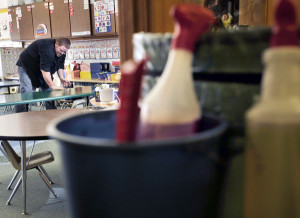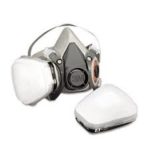Between the news, my social media feeds, email, and phone calls I know it’s flu season, how about you? Many who work in the IPM program are also involved in the school environmental health program as well, and there are lots of questions. The three big questions I get asked is what can we use, can we use disinfecting wipes, and do we need to post? Below are some of the best guidelines I can give you, along with some tips and documents to print and post.
Full disclosure this newsletter is more about cleaning and prevention, than what is the flu. And the prevention is more on school hygiene keeping the building safe, which is part of IPM, not what products you need to use.

Custodian Carl Crossman wipes down classroom tables as he makes his daily rounds. Cleaning in public areas is essential to keep the spread of cold and flu from happening.
The Centers of Disease Control and Prevention and the Texas Department of State Health Services (DSHS) have a lot of information on the flu, what to do if you get the flu, and how to clean to help with the spread of the flu. At times like this, knowing how to use cleaning products is key to success. To kill the bacteria or virus on a surface the cleaning agent must remain on that surface for up to 10 minutes (depending on disinfection/antimicrobial product). To be safe follow Federal regulations, read the label before you use any pesticide product, yes cleaning products are pesticides. DSHS has two good websites on How To Clean and Disinfect Schools To Help Slow the Spread of Flu and Information for Schools & Childcare Providers as they state on their website knowing the difference between cleaning, disinfecting and sanitizing.
The Department of Family and Protective Services and Department of State Health Services define sanitizing. They recommend for the sanitizing process to be effective, you must follow these four steps in order:
- Washing with water and soap
- Rinsing with clear water
- Soaking in or spraying on a disinfecting solution (at least two minutes). Rinsing with cool water only those items that children are likely to place in their mouths; and
- Allowing the surface or article to air-dry.
Sanitizing should be done on those surfaces everyone touches. The obvious are doors, door handles, and facet handles. The not so obvious, door handles in bathrooms, computers (screens, keyboards, headphones), shared devices like microscopes, keypads to enter a door, refrigerator doors in the breakroom, and the list goes on, the key sanitize those areas that most people touch frequently.
When it comes to cleaning materials the next big question I’m asked is about disinfecting wipes. While these are convenient cleaning wipes, some common sense needs to be used if you choose to use these in your school district. First, they are pesticides under the U.S. EPA Federal Insecticide Fungicide Rodenticide Act (FIFRA). Under FIFRA pesticides must have two statements; 1) signal word (Caution, Warning, Danger) and 2) child hazard statement (keep out of reach of children), these requirements are to alert the user that these products require personal protective equipment and cautionary use around children. Second, using these cleaning wipes for a quick clean up is great, but to keep things like door handles, common use items (fridge handles, faucet handles), and in food preparation areas use the sanitation steps above. Should you wear gloves when using these wipes? If I personally were cleaning up a small mess in my kitchen, nope not worth it to me. However, if I’m going to use these wipes every afternoon to wipe down the headphones, keyboards, desktops, paint brushes, microscopes, etc. (items the kids touched) then yes, I would probably wear a pair of disposable gloves that way I’m doubly protected. Our hands are very porous, hence why it’s so easy to transfer the cold and flu, but we also must protect ourselves from cleaning solutions entering our system as well. Remember after using these wipes wash your hands with soap and water.
Do I need to post? No, not unless one of the products you use require you to do so. If you are doing deep cleaning, using a misting type device, or some other type of cleaning that requires the employees to be protected, then you might want to think about notifying employees of these efforts. Again read that pesticide label, the label is the law.
Making sure employees are aware.
Recently the U.S. EPA updated their rules regarding the protection of agricultural workers for additional training, but with these updates it’s a good time to remind you about some of those training requirements for your school when it comes to using respirators while cleaning or applying herbicides.
If you have employees who need to wear a respirator to clean or repair an area, since 2015 employers are required to conduct medical evaluations of each employee. Wearing a respirator can put an extra burden on the body. People with underlying medical conditions may put themselves at risk if they work while wearing a respirator. The Occupational Safety and Health Administration (OSHA) requires medical evaluation before any employee can even be fit-tested for a respirator.
If respirators aren’t required in your workplace but employees wear them voluntarily, OSHA says you still must perform a medical evaluation. The sole exception is if the only type of respirator voluntarily worn is a filtering facepiece respirator (the paper mask type), then OSHA doesn’t require the medical evaluation. This means schools and all other employers still must make sure that their employees are medically fit to wear one of these devices.
The eight-page medical evaluation has portions for the employer and employee to complete. Upon completion the employer must select a physician or other licensed healthcare professional, such as a registered nurse or physician’s assistant, to perform the medical evaluation. The evaluation must consider the individuals health, specific job description, respirator type, and workplace conditions. To learn more about medical evaluations please visit the OSHA website to view the Respirator Medical Evaluation Questionnaire Check out this link. This is one of many areas that you will be learning more about over the next year as we discuss all the changes for pesticide applicators.
Finally, if you are interested in something new, check out this website Seal-N-Kill is a durable, flexible polymeric film that has antimicrobial features. It was something that caught my eye in 2016, but I haven’t seen much use, yet. This film is for places like door handles, push plates, and other common surfaces that you can apply this film material on. The research I have seen shows that after a year the film shows no growth of staphylococcus aureus, how it works on the flu virus has not been tested. However, this is something to consider, especially if you have certain areas that are heavily used by the public. I would be interested to learn of your results.
Below are a variety of links for handouts and more information. Make sure everyone in the district understands their role in this process, the cold and flu are spread by humans so changing behavior is essential. Make sure everyone washes their hands often, don’t touch your nose and mouth if possible (germ transfer), if you sneeze use a tissue or sleeve (not your hands – germ transfer), and if you are sick stay at home you will get better faster if you do.
Stay Healthy, Janet
AgriLife Extension Links to be Prepared for the Flu https://agrilifeextension.tamu.edu/blog/2018/01/11/flu-reported-widely-across-texas-prepared/
Excellent Handout to post Avoid the Flu at School and Work http://texashelp.tamu.edu/wp-content/uploads/2016/02/Avoid-Flu.pdf
Visit TexasFlu.org to obtain additional posters and handouts to use with staff and students
Centers for Disease Control and Prevention Website resources for Schools and Child Care Centers associated with flu https://www.cdc.gov/flu/resource-center/freeresources/print/print-schools-childcare.htm
This is a nice flyer to post on the best ways to clean to prevent the flu. Cleaning to Prevent the Flu
You can also find this handout in additional languages on the CDC website listed above.
DYI- disinfecting solution:
(A) One tablespoon of regular strength liquid household bleach to each gallon of water used for disinfecting such items as toys and eating utensils
(B) One-fourth cup of regular strength liquid household bleach to each gallon of water used for disinfecting surfaces



 .
.